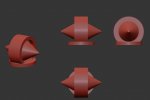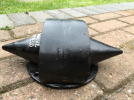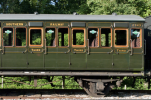You are using an out of date browser. It may not display this or other websites correctly.
You should upgrade or use an alternative browser.
You should upgrade or use an alternative browser.
Torpedo Roof Vents
- Thread starter LGB-Sid
- Start date
3 minutes of fame
3d printing, electronics and trams
Tip to tip should be about 300 - 320mm in full size.
LGB-Sid
Registered
Thanks I made them 12mm Long so not far out, they just look big on screen sat on the coach roof, but I have learnt that things often look smaller in real lifeTip to tip should be about 300 - 320mm in full size.
3 minutes of fame
3d printing, electronics and trams
Looks like a very heavy object. What is the purpose of this thing?I could only find a few photo references and worked out the distance based upon a full size unit sitting on top of a 600mm paving slab!
I wonder of your design is a bit "fat" and should be longer and slimmer to give a better look? Maybe increase the length of the cones?
View attachment 286506
Greg Elmassian
Guest
Simple, shoots torpedoes from something cleverly disguised as a roof vent 
A roof vent that looks like a torpedo... looks as the venturi effect causes motion in the air to "power" the vent, which would bolt to the roof, sucking air out of a car, looks like it works equally well in both directions...
Now I will look it up after sticking my neck out:
Apparently used on coaches: (from wikipedia)
Most coaches ran on two four-wheel bogies which were of a 9 ft 0 in wheelbase single bolster design which hardly changed for the whole of the company's life. Some special vehicles ran on twelve wheel chassis and the six-wheel bogie on these vehicles was of 12 ft 6 in wheel-base, based on the London and North Western Railway design. All coaches except kitchen cars were electrically lit and normally fitted with vacuum brake as standard.
But it looks like they don't align the way I thought:


so I wonder if someone can explain, perhaps they turn?
Ahh, some more information:
The torpedo roof vent reigned supreme for many years with only the GWR adopting the shell vent. The LMS adopted it in 1935 but only for a few years. Then they reverted to a vent that was virtually the Wolverton LNWR hemispherical roof vent of circa 1917. BR adopted it with minor mods for Mk.I stock.
Inside the coach the vents could be 'shut off' by a lever that closed the ventilation slots, although these varied from company to company. I wonder if anyone bothered. Ventilation was important in earlier times when smoking was 'normal'.
A roof vent that looks like a torpedo... looks as the venturi effect causes motion in the air to "power" the vent, which would bolt to the roof, sucking air out of a car, looks like it works equally well in both directions...
Now I will look it up after sticking my neck out:
Apparently used on coaches: (from wikipedia)
Coaches built by the LMS
The design and building of LMS coaches followed a very standardised pattern. Very many types of coaches were built to suit the various services and needs but, in general, the progression of design features was a logical one. Three quite distinct periods of design can be recognised,[2] the last of which continued until after nationalisation of the railways in Britain.Period I (1923–1928/9)
The general styling of LMS Period I coaches followed much the same ideas as were prevalent elsewhere in Britain. They were wooden framed and panelled, had a fully beaded body with a semi-elliptical roof, doors to all compartments of side-corridor coaches, and were mounted on a steel underframe derived from the final Midland Railway design. Window ventilation was mainly by droplight. Roof ventilators were generally of the torpedo type. The coaches were fitted with non-automatic screw couplers and gangwayed stock made use of scissors-type British Standard pattern corridor connection (as also used on the Great Western Railway).Most coaches ran on two four-wheel bogies which were of a 9 ft 0 in wheelbase single bolster design which hardly changed for the whole of the company's life. Some special vehicles ran on twelve wheel chassis and the six-wheel bogie on these vehicles was of 12 ft 6 in wheel-base, based on the London and North Western Railway design. All coaches except kitchen cars were electrically lit and normally fitted with vacuum brake as standard.
But it looks like they don't align the way I thought:


so I wonder if someone can explain, perhaps they turn?
Ahh, some more information:
The torpedo roof vent reigned supreme for many years with only the GWR adopting the shell vent. The LMS adopted it in 1935 but only for a few years. Then they reverted to a vent that was virtually the Wolverton LNWR hemispherical roof vent of circa 1917. BR adopted it with minor mods for Mk.I stock.
Inside the coach the vents could be 'shut off' by a lever that closed the ventilation slots, although these varied from company to company. I wonder if anyone bothered. Ventilation was important in earlier times when smoking was 'normal'.
I suspect that there are different sizes of Torpedo Vents, certainly the ones on the Southern Carriage have the look of being sat on by the Jolly Green Giant.Jury is still outit might be take two tomorrow after a bit of tweaking
View attachment 286619
My carriage is very loosely based on a Southern Carriage
View attachment 286620
3 minutes of fame
3d printing, electronics and trams
Very good! size looks OK for that size of coach. You could always rub down the bottom a bit so they sink into the roof a little.
trammayo
Interested in vintage commercial vehicle, trams, t
Is that a partial eclipse?The Southern ones, look to be part of an eclipse, rather than a whole circle?
PhilP




